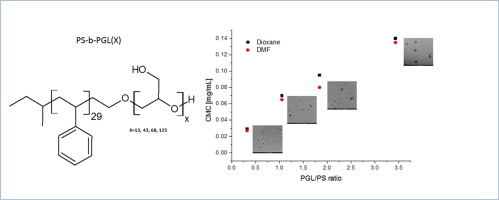当前位置:
X-MOL 学术
›
Eur. Polym. J.
›
论文详情
Our official English website, www.x-mol.net, welcomes your
feedback! (Note: you will need to create a separate account there.)
Micellisation of polystyrene-b-polyglycidol copolymers in water solution
European Polymer Journal ( IF 5.8 ) Pub Date : 2018-02-01 , DOI: 10.1016/j.eurpolymj.2017.12.010 Łukasz Otulakowski , Mariusz Gadzinowski , Stanisław Slomkowski , Teresa Basinska , Aleksander Forys , Andrzej Dworak , Barbara Trzebicka
European Polymer Journal ( IF 5.8 ) Pub Date : 2018-02-01 , DOI: 10.1016/j.eurpolymj.2017.12.010 Łukasz Otulakowski , Mariusz Gadzinowski , Stanisław Slomkowski , Teresa Basinska , Aleksander Forys , Andrzej Dworak , Barbara Trzebicka

|
Abstract The preparation of a set of amphiphilic polystyrene-b-polyglycidol (PS-b-PGL) diblock copolymers and their characteristics in aqueous media are described. The copolymers were prepared via anionic polymerisation starting from the synthesis of a polystyrene macroinitiator terminated by ethylene oxide, followed by anionic polymerisation of glycidol 1-ethoxyethyl ether to obtain a poly(1-ethoxyethyl glycidyl ether) block. The ethoxyethyl blocking groups of the hydroxyls were subsequently removed by hydrolysis. The copolymers differed in polymerisation degree of the polyglycidol block with DP values equal to 13, 43, 68 and 125, whereas the DP of polystyrene was 29. Two different organic media, N,N-dimethylformamide and dioxane, were used to prepare copolymer solutions dialysed afterward against water. The behaviour of diblock copolymers in water, their self-assembly and the size parameters of their aggregated structures were determined using dynamic light scattering. The critical micelle concentration (CMC) did not depend on the initial solvent and linearly increased with increasing content of hydrophilic glycidol units in the copolymer chain. However, above the CMC, the dispersions obtained from DMF contained a significant fraction of large aggregates. In the case of dioxane after dialysis, only one population of particles of the sizes, which can be related to typical core–shell micelles, was observed. Cryogenic transmission electron microscopy images revealed the presence of spherical objects and confirmed their sizes. PS-b-PGL micelles were highly stable and did not dissociate even after dissolution of their dispersions to concentrations below the CMC.
中文翻译:

聚苯乙烯-b-聚缩水甘油共聚物在水溶液中的胶束化
摘要 描述了一组两亲性聚苯乙烯-b-聚缩水甘油(PS-b-PGL)二嵌段共聚物的制备及其在水性介质中的特性。共聚物通过阴离子聚合制备,起始于合成由环氧乙烷封端的聚苯乙烯大分子引发剂,随后缩水甘油1-乙氧基乙基醚的阴离子聚合以获得聚(1-乙氧基乙基缩水甘油醚)嵌段。随后通过水解除去羟基的乙氧基乙基保护基团。共聚物的聚缩水甘油嵌段的聚合度不同,DP 值分别为 13、43、68 和 125,而聚苯乙烯的 DP 为 29。两种不同的有机介质 N,N-二甲基甲酰胺和二恶烷用于制备共聚物溶液之后用水透析。使用动态光散射测定二嵌段共聚物在水中的行为、它们的自组装和它们的聚集结构的尺寸参数。临界胶束浓度 (CMC) 不依赖于初始溶剂,并且随着共聚物链中亲水缩水甘油单元含量的增加而线性增加。然而,在 CMC 之上,从 DMF 获得的分散体含有大量的大聚集体。在透析后的二恶烷的情况下,仅观察到一组大小与典型核壳胶束相关的颗粒。低温透射电子显微镜图像揭示了球形物体的存在并确认了它们的大小。
更新日期:2018-02-01
中文翻译:

聚苯乙烯-b-聚缩水甘油共聚物在水溶液中的胶束化
摘要 描述了一组两亲性聚苯乙烯-b-聚缩水甘油(PS-b-PGL)二嵌段共聚物的制备及其在水性介质中的特性。共聚物通过阴离子聚合制备,起始于合成由环氧乙烷封端的聚苯乙烯大分子引发剂,随后缩水甘油1-乙氧基乙基醚的阴离子聚合以获得聚(1-乙氧基乙基缩水甘油醚)嵌段。随后通过水解除去羟基的乙氧基乙基保护基团。共聚物的聚缩水甘油嵌段的聚合度不同,DP 值分别为 13、43、68 和 125,而聚苯乙烯的 DP 为 29。两种不同的有机介质 N,N-二甲基甲酰胺和二恶烷用于制备共聚物溶液之后用水透析。使用动态光散射测定二嵌段共聚物在水中的行为、它们的自组装和它们的聚集结构的尺寸参数。临界胶束浓度 (CMC) 不依赖于初始溶剂,并且随着共聚物链中亲水缩水甘油单元含量的增加而线性增加。然而,在 CMC 之上,从 DMF 获得的分散体含有大量的大聚集体。在透析后的二恶烷的情况下,仅观察到一组大小与典型核壳胶束相关的颗粒。低温透射电子显微镜图像揭示了球形物体的存在并确认了它们的大小。











































 京公网安备 11010802027423号
京公网安备 11010802027423号